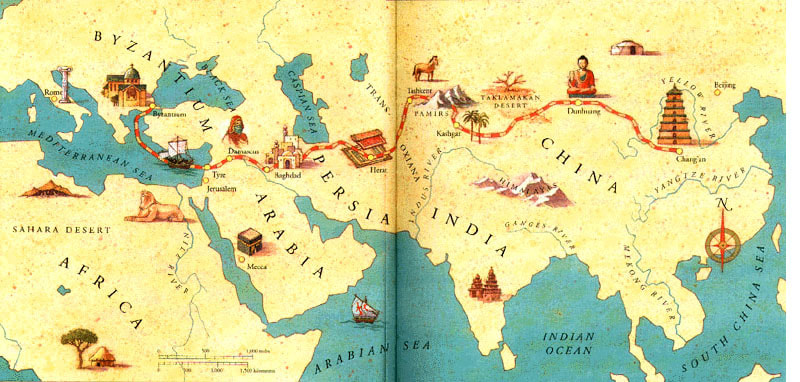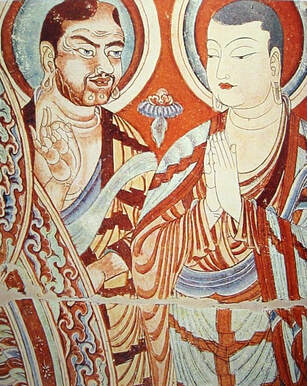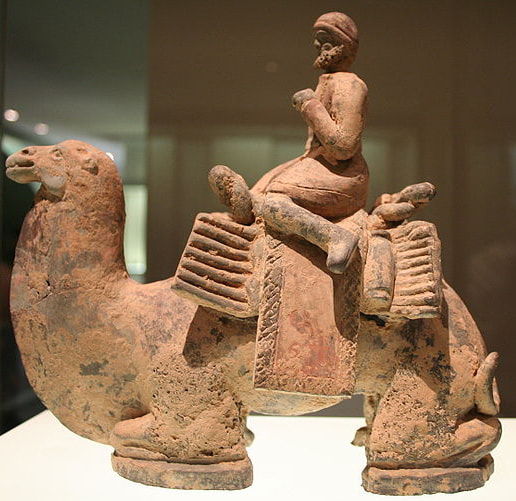History of the Ancient Chinese Silk Road
History of the Ancient Chinese Silk Road
The Chinese Silk Road was an extensive network of interconnected trade routes that historically linked civilizations across Southeast Asia, Arabia and Eastern Europe. The Silk Road crossed over 40 countries during different periods of history; routes over both land and sea extended over vast distances and eventually spread as far as East Africa, the Mediterranean and India. Estimates suggest the Silk Road began taking shape in the 2nd century BC and trade routes remained in use until the 16th century AD.
The system of trade routes became known as the ‘Silk Road’ due to the famous Chinese silk trade. However, silk yarn and textiles were not the only goods transported along the Silk Road. Food items such as fruits, vegetables and grains were carried back and forth along the various routes. Animals, tools, works of art and religious objects, incense and timber were also traded between civilizations. China exported valuables such as tea, porcelain, spices, ivory and paper after the Chinese paper industry developed when technological advancements led to substituting silk threads for the cotton fibers found in imported paper. China also imported a variety of goods and foods including: warhorses, spices, fragrances, wine, precious stones, gold, silver and glassware.
The Chinese Silk Road was an extensive network of interconnected trade routes that historically linked civilizations across Southeast Asia, Arabia and Eastern Europe. The Silk Road crossed over 40 countries during different periods of history; routes over both land and sea extended over vast distances and eventually spread as far as East Africa, the Mediterranean and India. Estimates suggest the Silk Road began taking shape in the 2nd century BC and trade routes remained in use until the 16th century AD.
The system of trade routes became known as the ‘Silk Road’ due to the famous Chinese silk trade. However, silk yarn and textiles were not the only goods transported along the Silk Road. Food items such as fruits, vegetables and grains were carried back and forth along the various routes. Animals, tools, works of art and religious objects, incense and timber were also traded between civilizations. China exported valuables such as tea, porcelain, spices, ivory and paper after the Chinese paper industry developed when technological advancements led to substituting silk threads for the cotton fibers found in imported paper. China also imported a variety of goods and foods including: warhorses, spices, fragrances, wine, precious stones, gold, silver and glassware.
Geography of the Silk Road
The Silk Road stretched over extremes in geography, spanning massive rivers and lakes, salt flats, vast deserts, mountain ranges, forests, fertile prairies and crossing straits and oceans. At various points along the Silk Road, merchants transported goods by pack animals or by small river crafts. In other sections, caravans of horses or camels carried goods over land.
The terrestrial routes of the Silk Road were frequently impacted by geopolitical struggles and conflicts between warring neighbors. The seasons and water levels also influenced the ability of merchants to transport goods over land and resulted in an increased number of paths connecting Silk Road settlements.
While ships were a faster and easier method of transportation, pirates and storms plagued the maritime Silk Road. Sailing was also extremely dangerous and unaided by modern ships, maps and other navigational aids. Chinese ships engaged in long-distance trade and functioned without the aid of navel or political protection of the Chinese state. However, Chinese vessels had been making international journeys for centuries and assisted in the establishment of foreign trade and diplomatic relationships with civilizations thousands of miles from China. Simple merchants became influential diplomats, spreading culture and trade between civilizations.
The Silk Road stretched over extremes in geography, spanning massive rivers and lakes, salt flats, vast deserts, mountain ranges, forests, fertile prairies and crossing straits and oceans. At various points along the Silk Road, merchants transported goods by pack animals or by small river crafts. In other sections, caravans of horses or camels carried goods over land.
The terrestrial routes of the Silk Road were frequently impacted by geopolitical struggles and conflicts between warring neighbors. The seasons and water levels also influenced the ability of merchants to transport goods over land and resulted in an increased number of paths connecting Silk Road settlements.
While ships were a faster and easier method of transportation, pirates and storms plagued the maritime Silk Road. Sailing was also extremely dangerous and unaided by modern ships, maps and other navigational aids. Chinese ships engaged in long-distance trade and functioned without the aid of navel or political protection of the Chinese state. However, Chinese vessels had been making international journeys for centuries and assisted in the establishment of foreign trade and diplomatic relationships with civilizations thousands of miles from China. Simple merchants became influential diplomats, spreading culture and trade between civilizations.
UNESCO and the Silk Road
Beyond sponsoring advances in international trade relations and the flow of ideas, hundreds of monuments and historical sites representing the interactions of peoples and cultures brought together by the Silk Road sprang up along the various land routes and port cities.
Examples of heritage sites that the United Nations Educational, Scientific and Cultural Organization (UNESCO) recognizes as part of the ancient Silk Road include: sections of the Great Wall constructed to prevent bandits from raiding caravans and hindering international trade; Buddhist cave temples and shrines, built by merchants and missionaries who carried their religion with them into China; and trading settlements, posthouses and beacon towers used by Chinese merchants to facilitate trade.
Researchers may never grasp the full extent of the ancient Silk Road. China has provided protection to many of the sites and ruins along the Silk Road, but in other nations the archeological history of the Silk Road has been destroyed or buried. However, the impact of the cross-cultural Silk Road is still evident.
Beyond sponsoring advances in international trade relations and the flow of ideas, hundreds of monuments and historical sites representing the interactions of peoples and cultures brought together by the Silk Road sprang up along the various land routes and port cities.
Examples of heritage sites that the United Nations Educational, Scientific and Cultural Organization (UNESCO) recognizes as part of the ancient Silk Road include: sections of the Great Wall constructed to prevent bandits from raiding caravans and hindering international trade; Buddhist cave temples and shrines, built by merchants and missionaries who carried their religion with them into China; and trading settlements, posthouses and beacon towers used by Chinese merchants to facilitate trade.
Researchers may never grasp the full extent of the ancient Silk Road. China has provided protection to many of the sites and ruins along the Silk Road, but in other nations the archeological history of the Silk Road has been destroyed or buried. However, the impact of the cross-cultural Silk Road is still evident.
|
Linking multiple civilizations through an interconnected network of land and maritime trade routes, China facilitated an expansive exchange of goods, ideas and technology. Trading religious beliefs, culture and traditions, scientific knowledge and the arts, China has an extensive history of sponsoring international engagement and cultural connectivity.
Collapse of the Silk Road The vast network was not always a positive influence on China. The Silk Road carried the bubonic plague throughout China and also provided the framework for later European maritime invasions. Roads led both directions and the fall of the Silk Road came during the Ming Dynasty when isolationist politics recognized the Western influences making inroads into China through the ancient trade routes. Similarly, during this time period the Ottoman Empire closed trade routes with the West, effectively halting trade components vital to the continuance of the Silk Road. The Silk Road collapsed as European influences took over international trade. Cities and settlements along the centuries-old paths fell into ruin as wealthy merchants moved on in search of renewed prosperity. However, remnants of the Silk Road can still be found in modern Chinese ideology on diplomatic relations and foreign trade. |


